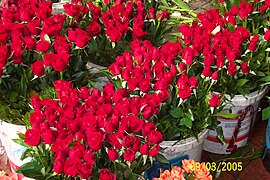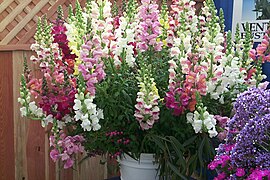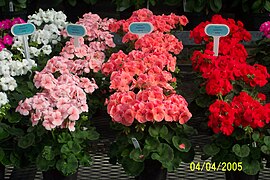Floral industry

The floral industry is focused on the production, distribution and sale of flowers for human enjoyment. The floral industry began in the Golden Century of the Netherlands, where flowers were grown on a large scale on vast
For example, the U.S. Agricultural Census identifies six categories of "flowers".[2] Most U.S. consumers purchase "flowers" as a general category because plant purchases are made based on appearance and enjoyment, not by name. These groups are just for convenience to help organize the long list of flowering plants in the floral industry. The groups are Cut Flowers, Cut Cultivated Greens, Annual Bedding/Garden Plants, Potted Flowering Plants, Herbaceous Perennial Plants, Foliage Plants - Indoor/Patio Use, Propagative Floriculture Materials. Generally, these are garden flowers and houseplants, most produce attractive flowers, while some offer attractive foliage. Although these plants are from diverse native habitats and taxa, years of selection have found those that can be produced economically and are adaptable to the human environment.
The floral industry includes transportation companies, brokers, and wholesalers that ship the flowers from the production location to population centers around the world where the flowers are purchased. Additionally, the floral industry includes plant breeders and companies that sell seed, bulbs, and cuttings, and companies that sell greenhouses, pots of all kinds, potting soil, labels and marketing supplies, fertilizer, pesticides and machines for plant production activities. The service segment includes floral designers and florists, garden designers, and interior and exterior landscaping companies. Garden centers, supermarkets and hardware stores add the retail segment to the floral industry.[3][4][5]
Cut flowers and cut cultivated greens
-
Sunflower - Helianthus annuus
In the 1950s and 1960s, the center of cut flower production[6][7][8] was near the largest consumers; production was local. The developed world, Japan, Western Europe and North America, were both major producers and consumers. In 2021, the world wide cut flower market is estimated at US$10.8 Billion, wholesale value, based on trade statistics from 114 countries.[9] The major importers of cut flowers, as percent of world cut flower imports, in 2021 were the United States (21%), Germany (15%), the Netherlands (12.5%), the United Kingdom (9.4%), Russia (5%), France (4.6%).[9]
The Netherlands and the history of the flower industry
The Tulip was a wild flower growing in Central Asia when it was first cultivated by the Turks as early as 1000AD. Mania in Turkey struck in the 16th century, at the time of the Ottoman Empire, when the Sultan demanded cultivation of particular blooms for his pleasure. Tulips became popular garden plants in the east and west, but, whereas the tulip in Turkish culture was a symbol of paradise on earth and had almost a divine status, in the Netherlands, it represented the briefness of life.
The Netherlands remains the center of production for the European floral market, as well as a major international supplier to other continents. The flower auction at Royal FloraHolland[10] is the largest flower market in the world. Since the mid-1970s, the production and distribution of cut flowers in the Netherlands has burgeoned. Billions of cut flowers are shipped to the Netherlands every year to be sold at auction followed by immediate transport to buyers around the world.
New flower growing centers
Experts believe that the production focus has moved from traditional growers to countries where the climates are better and production and labor costs are lower. This has resulted in a paradigm shift in the floral industry. The Netherlands, for instance, has already shifted attention from flower production to flower trading, though it plays an important role still in the development of flower genetics. The new centers of production are developing countries like Ecuador (largest producer and exporter of roses worldwide), Colombia (second largest exporter in the world and with a market more than 40 years old), Ethiopia, Kenya, and India. Other players in this global industry are Mexico, Israel, South Africa, Australia, Thailand and Malaysia. New Zealand, due to its position in the Southern Hemisphere, is a common source for seasonal flowers that are typically unavailable in Europe and the United States.
In Africa, Kenya is the largest exporter, supplying a significant percentage of Europe's flowers. The industry there is represented by the Kenya Flower Council.


In
In South America, Colombia is the leading cut flower producer and exporter accounting for 59% of all flowers imported to The United States in 2006. The United States imports 82% of its cut flowers. Growers in the United States state that 3 out of 4 flowers in the United States are grown outside the US with Colombia being the biggest exporter. The United States signed a free trade agreement with Colombia and that has lowered the cost of Colombian flowers in the United States. Ecuador has become, in recent years, the leading South American rose producer and is well known throughout the world for its high quality, large headed roses due to the high altitude location of its rose farms.[9]
Annual Bedding/Garden Plants
-
Pansy - Viola x wittrockiana
Traditionally, the flowering plants in this group are planted for public and personal display in garden beds in municipal parks, outside public buildings and in many personal landscapes. As time has passed, it is common to see these plants in various types of container gardens, on public plazas or patios and porches around the world. These plants are used for seasonal gardens, spring, summer, fall or winter, depending on the climate where the garden is located. Some plants perform best in cool weather (even frost tolerant) and others need the summer heat for best performance. Some are annuals in nature, others are perennial in their natural habitat, but may be treated as annuals in a seasonal garden. In the past, it was common for these plants to be grown from seed and sold at a small size in 5 cm (2 inch), approximately, pots or packs. Plant and pot size have increased in the last 20 years and many cultivars are now grown from cuttings. Vegetable transplants, from seed, are sold in small to large pots and are included in this group.
The production of bedding plants remains local.[7][8] Most governments have pest quarantines that prevent the shipment of plants in potting soil between countries. These rules protect all of agriculture from major disease and insect pests.
In the U.S., bedding plants are the top selling group of flowers with nearly 40% of total sales, nearly US$ 2.5 Billion, wholesale value, in 2022.[2] This group of plants has significant sales in many countries because they are locally produced.
Potted Flowering Plants
This group of flowering plants
Foliage Plants - Indoor/Patio Use
Most people would say foliage plants[11] are houseplants. This is true, however, the industry calls this group foliage plants. There are hundreds of species and thousands of cultivars of plants that can be grown inside and outside of the home. Most of these houseplants are exterior landscape plants in tropical and subtropical climates. They are grown for their striking appearance from color patterns in the leaves or colorful flowers. Over the past 300+ years, plant fanciers have found these plants in tropical and subtropical areas, found they were relatively easy to propagate and found they could survive in the human environment. Even though they may grow in full sunlight naturally, many can tolerate lower light levels indoors. Even though they don't grow in containers naturally, they will tolerate a small space for their root system. Even though they may have evolved in a humid climate, they can tolerate the low humidity of the human environment. The foliage plants most tolerant of the human environment are the most successful houseplants in the floral industry.
Herbaceous Perennial Plants
Back to common flower garden plants for this group, herbaceous perennial plants.[12] These plants are perennial, they come back every year in their optimal climate range. The plants are relatively permanent in the flower garden but the flowers will occur for only 2-6 weeks each year. The gardening strategy (herbaceous perennial border) is to mix the plants so there are plants flowering, spots of color, throughout the garden, throughout the seasons. Relatively easy to do in cool temperate climates, such as northern Europe or in New England states of the US, but difficult in southern Europe, regions of India or Texas in the southern US. However, many herbaceous perennials have been selected from the southern US flora since 1990, so perennials are a significant group of the floral industry.[12]
Propagative Floriculture Materials
-
Seedlings in a plug tray.
-
Greenhouse adapted to seedling production.
The production of flower seedlings and cuttings, young plants, has become its own group in the floral industry. Companies have become specialized to grow flower plants from seed, cuttings, bulbs, corms, tubers, grafting/budding, air layers and plant tissue culture.[13] Some of these companies are large enough to have plant breeders to develop new cultivars. The young plants are shipped to other plant production greenhouses to finish and distribute the plants to service businesses or to retailers. Specialized young plant growers can increase the yield and turnover of young plants with specialized facilities. Producers of cuttings and tissue culture explants can ship their product anywhere in the world because potting soil quarantines are not involved. These companies are often located in tropical climates around the world to meet the world market demands.
Floral industry markets
The plants of the floral industry brighten and enhance the human environment. Many people are employed to bring these plants to humans that enjoy and need them.[14]
The retail segment is composed of people who make all or a portion of their salary selling flowers and plants. Local independent garden centres and florists lead the list, with local nurseries, interior landcape (plantscaping) and retail greenhouses close behind. Generally, these businesses sell only plants along with related professional design and installation services. Extensive plant knowledge is often an important consideration to consumers. Local hardware stores (home improvement centers), supermarkets and department stores sell flowers and plants to consumers as well. Flowers and plants are also sold at local farmers' markets, roadside stands, sidewalk shops, etc. Cut flowers, seeds, supplies and plants are also sold by mail order companies direct to consumers.
The wholesale segment supports the retail segment by delivering flowers and plants on a timely basis. Garden centres are supplied by large regional greenhouses and nurseries where the plants are grown to the garden centres specifications. Hardware stores are supplied by much larger greenhouses and nurseries that grow the plants and supply many hardware stores in a multi-state area. The plants are shipped in trucks on carts after they have been "packaged" at the greenhouse. Most of the plants are distributed based on contracts negotiated months before sales occur. The largest greenhouses and nurseries often hire merchandizing companies to manage the plants at the hardware stores. Florists receive cut flowers and cut cultivated greens from regional wholesale florists. The wholesale florists receive large shipments of boxes of cut flowers, condition the flowers and redistribute them to florists on a truck route. The flowers can come from anywhere in the world and are picked up at an airport or delivered by truck. Supermarkets receive flowers and plants from the company's distribution center. Cut flowers come to the distribution centers from anywhere in the world and potted plants will come from regional greenhouses and nurseries.
Allied trade companies are also important to the floral industry:
- Plant breeders produce the hundreds of improved cultivars needed in the industry as older cultivars are replaced.[15] The majority of the industry's plants are propagated vegetatively, these plants mutate over time and must be replaced with improved cultivars.
- Current and new cultivars are propagated by companies that sell seed, bulbs, cuttings, plugs (young plants), tissue culture explants, etc. to the large wholesale greenhouses and nurseries, locally and throughout the world, to produce the flower crops.
- Young plants of roses, carnations, chrysanthemums, etc. are distributed to the large growers in the Netherlands, Colombia, Kenya, China, India, etc. that will grow the cut flower crops. For example, rose plants, will produce flowers for sale for 5 years or more at a cut flower greenhouse.
- Similarly, young plants will be distributed for bedding plant, potted flowering plant and foliage plant production. Seed of impatiens plants will be sown at a young plant grower, shipped 4-6 weeks later to a production greenhouse, transplanted by a robotic transplanting machine, grown for 4 weeks, loaded onto a truck and sold to a consumer a few days later.
- The companies that design, manufacture, and construct greenhouses are a key part of the floral industry. These companies bring the pieces of controlled-environment agriculture (CEA) to the flower business by integrating heating, cooling, supplemental lighting, irrigation, water quality, fertilizers, materials handling, etc. The companies that design and install robotic equipment and transplanting machines for the greenhouse and for grading and packaging cut flowers participate here.
- The manufacture and sale of containers are an integral part of the floral industry.

Procona system for shipping cut flowers in water on pallet - Start with the cardboard boxes for shipping cut flowers and cut greens and the large containers for air transport.
- Some flowers are packed in pallets covered with a special grade of stretch film called Air-O film[16] that allows air circulation in the pallets.
- Certain flowers, tropical flowers - or are transported in buckets of water (Dutch flower bucket and Procona). The latter method extends the life of flowers and reduces labour time as flowers are ready for sale, but also reduces the amount of flowers that can be transported as they are much heavier than dry-packed flowers and hence air transportation charges are higher.[17]
- Containers for floral arrangements of all kinds.
- Clay and plastic pots and saucers of all sizes.
- Bedding plant trays, flats, inserts of all sizes and configurations.
- Compostable materials used for pots and trays.
- Companies that harvest materials, peat, bark, coir, perlite, etc., for potting soil (growing media), process and package these materials.
- Pest management companies have diversified over the last 20 years. Pesticides to control insects, mites, diseases (pathogens), mollusks (snails, slugs), etc. have had a primary role in the floral industry. Flowers have been sold as a "flawless thing of beauty" so pests and damage from pests had to be eliminated for flower sales to occur. Initially, many of the worst chemicals were used because flowers were not consumed so there was no health threat. Pesticide chemicals have become safer since the 1970s and, unfortunately, are still used.[18][19] Integrated pest management practices began in the 1980s and have continued to develop. The use of predatory insects to control the primary pest (whiteflies, thrips, mites, aphids, mealybugs) problems has continued to increase.[20] [21][22] Long term crops, such as roses, have changed from the most pesticides applied to few pesticides applied because of the use of biological pest control of the insect and mite pests. It is still difficult to use biological pest control on short term crops, such as many bedding plants, but growers continue to reduce pesticide usage.[23]
Companies
- Bill Doran Company (USA)
- Florists' Transworld Delivery (FTD) (USA)
- Teleflora (USA)
- 1800 Flowers(USA)
- more florist companies by category
Trade organizations
- Royal FloraHolland
- Asocolflores Colombia
- Society of American Florists U.S.
- Commercial Horticultural Association (CHA) U.K.
- Produce Marketing Association U.S.
- British Florist Association
- Ethiopian Horticulture Producer Exporters Association (EHPEA)
- National Greenhouse Manufacturers Association U.S.
- AmericanHort U.S.
- Kenya Flower Council
- Indonesian Flower Association (ASBINDO)
See also
References
- ^ Floriculture Market 2022. Size, Share, Growth. Trends, Recent Developments, Company Profiles, Key Suppliers, Production Capacity, Revenue & Gross Margin, Market Drivers, Opportunities, Challenges and Forecast 2028. Market Reports World. April 04, 2022 07:48 ET.
- ^ a b c 2022 Commercial Floriculture Survey NASS’s Quick Stats. National Agricultural Statistics Service. United States Department of Agriculture. 05/31/2023.
- ^ "Sectoral Activities Department (SECTOR)". Ilo.org. Retrieved October 27, 2016.
- ^ "Australian Cut Flower Industry". Archived from the original on May 10, 2008. Retrieved October 27, 2016.
- ^ Gardening (2007-07-13). "Country roses: A cut above". London: Telegraph. Retrieved October 27, 2016.
- ^ Armitage, Allan M (1993). Specialty cut flowers. The production of annuals, perennials, bulbs and woody plants for fresh and dried cut flowers. cabdirect.org.
- ^ a b c Dole, John M; Wilkins, Harold F. (2004). Floriculture: Principles and Species (2nd ed.). Pearson.
- ^ a b c Larson, Roy A (2013). Introduction to Floriculture. United States: Elsevier Science.
- ^ a b c "Trend Economy".
- ^ "Royal FloraHolland".
- ^ Griffith, L. P. (1998). Tropical Foliage Plants: A Grower's Guide. United States: Ball Pub..
- ^ a b Allan M. Armitage 2020. Herbaceous Perennial Plants: A Treatise on their Identification, Culture, and Garden Attributes. 4th edition. Stipes Publishing Co.
- ISBN 978-0134480893.)
{{cite book}}:|last=has generic name (help)CS1 maint: multiple names: authors list (link - ^ Armitage, Allan (June 8, 2023). "Are Ornamental Plants Really Necessary? Our Customers Say Yes". Greenhouse Grower.
- ISSN 0567-7572.
- ^ "Air-O-Film-Maxx".
- ^ Reid, M. S., & Jiang, C. Z. (2012). Postharvest biology and technology of cut flowers and potted plants. Horticultural reviews, 40, 1-54.
- ^ David Smitley and Jeremy Jubenville (February 7, 2023). "Greenhouse Insect Pest Management 2023".
- ^ Raymond A. Cloyd (2021). "New Pesticides for Use in Greenhouse Production Systems 11/1/2021".
- ^ Casey, C., Newman, J., Robb, K., Tjosvold, S., MacDonald, J., & Parrella, M. (2007). IPM program successful in California greenhouse cut roses. California agriculture, 61(2), 71-78.
- ^ Redmond, J. C., Marois, J. J., & MacDonald, J. D. (1987). Biological control of Botrytis cinerea on roses with epiphytic microorganisms. Plant Disease, 71(9), 799-802.
- ^ Pijnakker, J., Vangansbeke, D., Duarte, M., Moerkens, R., & Wäckers, F. L. (2020). Predators and parasitoids-in-first: From inundative releases to preventative biological control in greenhouse crops. Frontiers in Sustainable Food Systems, 4, 595630.
- ^ Marsh, T. L., & Gallardo, K. (2009). Adopting biological control for ornamental crops in greenhouses. CABI Reviews, (2009), 1-9.
























